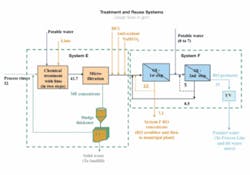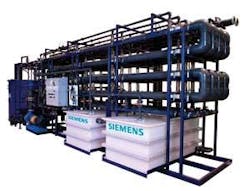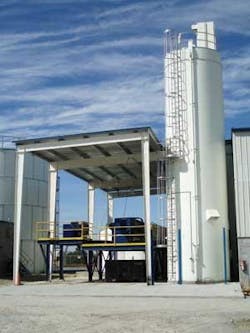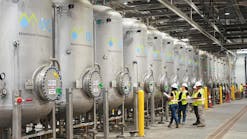By Wendy Searight
Microfiltration and RO reduce cost and water use for metals product maker.
Water availability, water quality and the cost to purchase and dispose of water are driving more industrial wastewater treatment plants to implement water reuse technologies. Nowhere is this more apparent than in semi-arid northern Mexico, which is home to a number of industrial sites.
Manufacturers with metal-laden wastewaters find it especially difficult to produce reuse-quality effluent, as a metals manufacturer in northeastern Mexico discovered in 2006, when installing a surface treatment process line in its facility. As the facility doesn’t directly discharge wastewater into a publicly owned treatment works (POTW) or local stream, the plant would have had to haul any wastewater generated from the new process line offsite, presenting logistics problems as well as significant transportation costs. The manufacturer also would have had to invest in a separate process water purification system to produce water high enough in quality to use as rinse water in the process line.
After carefully considering and evaluating several options, the manufacturer installed a wastewater recycle system (WRS) from Siemens Water Technologies. With a design flow of 32 gallons per minute (gpm), the system uses a staged approach to purify wastewater from the process line to the point where it can be re-used for rinsing. High concentrations of metallic ions, inorganic salts and total dissolved solids (TDS) are first removed from the wastewater via chemical precipitation followed by microfiltration (MF). The TDS concentration is then greatly reduced via a two-pass reverse osmosis (RO) system.
Reducing Contaminants
The Mexican manufacturer’s influent wastewater is processed through a two-stage reaction system to precipitate inorganic salts and metal ions. Each stage consists of a reaction tank, pH probe, lime slurry injection valve and mixer. Calcium hydroxide (lime) is added to each stage to convert the soluble inorganic compounds to insoluble calcium salt and the soluble metallic ions to insoluble metal hydroxide. Adding lime also increases the wastewater’s pH, optimizing precipitation. The wastewater then overflows from the second reaction tank into the MF system’s concentration tank, beginning solids separation.
Siemens’ advanced MF system uses cross-flow filtration to remove precipitated calcium salt and metal hydroxide particles, producing superior effluent quality. This filtration process converts soluble particles into insoluble forms that can be effectively separated from the waste stream. The membrane system also provides a barrier to the passage of solids, which protects downstream processes such as RO from total suspended solids (TSS) plugging or fouling.
An MF system from Siemens Water Technologies.
Waste slurry is then pumped from the microfilter concentration tank at a high velocity through the center of membrane tubes and returned back to the concentration tank, with each pass through the membrane concentrating the slurry a little more. To prevent rapid fouling or plugging, the membranes are back-pulsed with air and treated water. Meanwhile, the clear water (or permeate) is allowed to pass through the membrane and exit the MF system, after which it’s directed to the RO pretreatment system.
Solids are removed from the concentration tank, pumped automatically via duplex air-operated diaphragm pumps to a sludge holding tank, and then directed to a filter press that further dewaters the slurry to about 30% dry solids. Slurry is pumped into the feed inlet of the filter press plate pack where it’s evenly dispersed into each chamber. Solid particles are deposited on the filter cloth’s surface. After the filtrate passes through this particle build-up, it’s channeled through the discharge surface of the filter plates. Pumping pressure correlates with the particle deposit build-up. When the filter press cycle is complete, the feed pump automatically turns off, the hydraulic pressure is released and the press is ready for emptying.
The MF system, in conjunction with the two-stage chemical reaction system, removes about 99% of the metallic ions and 95% of the inorganic salts entering the system. In addition to removing these contaminants, the microfilter/chemical reaction system combination also reduces TDS concentration by about 70%, which helps provide for a more efficient RO system, thereby lowering operating costs.
Permeate & Concentrate Reuse
Before removing additional TDS via a RO system, chemical pretreatment is needed. This is accomplished in a RO pretreatment system that consists of a chemical reaction tank with a chemical metering pump and mixer, as well as pH and ORP probes. Sodium bisulfite is added to destroy any residual oxidizing agents present in the wastewater; hydrochloric acid, to reduce wastewater pH and to help prevent scaling of the RO membranes; and antiscalant, to prevent RO membrane scaling.
Following RO pretreatment, the wastewater is transferred to the RO system, where it’s processed through 5-µm cartridge filters to help prevent TSS from plugging the RO membranes. The chemically preconditioned wastewater is then pressurized and processed through the first-pass seawater RO elements. Here, applied pressure reverses the natural osmotic effect in which a dilute salt solution passes through an osmotic membrane into a more concentrated salt solution. Seawater elements are used to maximize TDS rejection, determined by the physical/chemical equilibrium established across the membrane and related to the pressure and concentration differences across the membrane. This first-pass RO system is operating at about 80-85% recovery and rejecting about 97% of the TDS in the microfilter permeate.
To maximize water usage, the metals manufacturer uses a portion of the first-pass RO system concentrate as make-up water for a fume scrubber on the process line. The remaining first-pass RO system concentrate is hauled offsite for disposal. Resulting product water is then mixed with make-up water and processed through a second-pass RO system to further purify the wastewater. The make-up water is added to replenish wastewate removed as concentrate in the first-pass RO system. The second-pass RO system operates similarly to the first-pass RO system, with the former achieving about 75-80% recovery and rejecting about 85-90% of the TDS that remain in the wastewater. Permeate from the second-pass RO system has a conductivity of less than 50 µS.
The lime silo and filter press.
Concentrate from the second-pass RO system is reprocessed through the first-pass RO system to maximize the amount of wastewater recovered. Resulting product water is then directed to a large storage tank prior to being pumped to the process line for reuse.
Quality Assurance
Installing the WRS has minimized the amount of wastewater the manufacturer hauls offsite. The system also eliminated the need to purchase a separate process water purification system to supply purified water to the process line, resulting in capital and operating cost savings as well as a reduced facility footprint.
Prior to shipping the equipment to the metals manufacturer’s site, Siemens performed a Factory Acceptance Test (FAT) at its manufacturing facility in Holland, Michigan, USA. The FAT verified the system process controls and wet-tested the MF system. The customer and its contractor attended the FAT, which allowed for visual reinforcement of the equipment drawings previously provided as well as the opportunity to ask any questions about equipment installation.
Siemens provided on-site startup and operator training once the system was installed. Training consisted of both classroom instruction and hands-on mechanical and process training.
Author’s Note:
Wendy Searight is an applications engineer with Siemens Water Technologies Corp. in Warrendale, Pennsylvania, USA. She has over10 years of experience in the industrial wastewater and wastewater recycle business, with an emphasis in plating, microelectronics and automotive applications. Contact: 724-772-1221 or [email protected]





